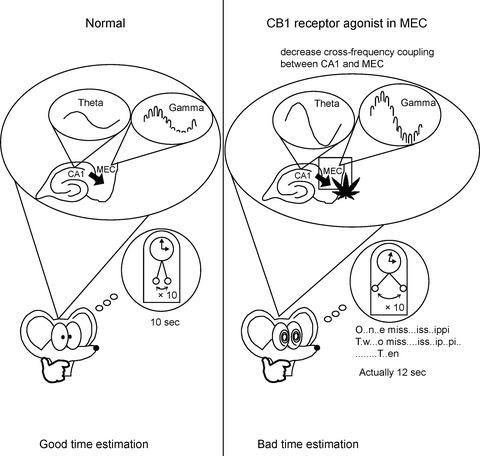当前位置:
X-MOL 学术
›
Eur. J. Neurosci.
›
论文详情
Our official English website, www.x-mol.net, welcomes your
feedback! (Note: you will need to create a separate account there.)
Activation of cannabinoid type 1 receptors decreases the synchronization of local field potential oscillations in the hippocampus and entorhinal cortex and prolongs the interresponse time during a differential‐reinforcement‐of‐low‐rate task
European Journal of Neuroscience ( IF 2.7 ) Pub Date : 2020-06-08 , DOI: 10.1111/ejn.14856 Wan‐Ting Liao, Chao‐Lin Chang, Yi‐Tse Hsiao
European Journal of Neuroscience ( IF 2.7 ) Pub Date : 2020-06-08 , DOI: 10.1111/ejn.14856 Wan‐Ting Liao, Chao‐Lin Chang, Yi‐Tse Hsiao

|
Marijuana intoxication impairs neurocognitive functions. Common side effects of consuming cannabis include time distortion and memory loss. However, the underlying neurophysiological mechanisms involved in these effects remain unclear. We hypothesized that communication between the hippocampal CA1 region and medial entorhinal cortex (MEC) is essential for the transmission of temporal‐associated information. We used a differential‐reinforcement‐of‐low‐rate (DRL) task, which requires subjects to press a lever at an optimal time point, to correlate the distributions of interresponse time (IRT) with local field potentials (LFPs) recorded in the CA1 and MEC under the effects of a cannabinoid type 1 (CB1) receptor agonist. We used a DRL 10‐s schedule and trained the rats to withhold for 10 s before pressing a lever. Our data showed that the percentage of 12.4‐ to 14‐s IRT events rose after activation of CB1 receptors in the MEC. In addition, gamma amplitude synchronization and CA1 theta phase–MEC gamma amplitude coupling decreased during the 6‐ to 14‐s IRT events. These results suggest that activation of CB1 receptors in the MEC disrupt the functional connectivity between the CA1 and the MEC. This inefficient communication may result in increased IRT during a DRL schedule. Overall, we postulate that marijuana intoxication impairs the communication between the CA1 and MEC and influences behavioral performances that require precise timing ability.
中文翻译:

大麻素1型受体的激活降低了海马和内嗅皮层局部场电位振荡的同步性,并延长了微分强化低速任务中的相互作用时间
大麻中毒会损害神经认知功能。食用大麻的常见副作用包括时间失真和记忆丧失。但是,涉及这些作用的潜在神经生理机制仍不清楚。我们假设海马CA1区与内侧内嗅皮质(MEC)之间的通信对于传递与时间相关的信息至关重要。我们使用了低速微分强化(DRL)任务,该任务要求受试者在最佳时间点按一下控制杆,以将响应时间(IRT)的分布与记录在仪器中的局部场电势(LFP)相关联。 CA1和MEC在1型大麻素(CB1)受体激动剂的作用下。我们使用DRL 10秒时间表,并训练大鼠在按下操纵杆之前将其扣留10秒。我们的数据显示,激活MEC中的CB1受体后,IRT事件的12.4至14s百分比上升。此外,在6到14 s IRT事件期间,伽马振幅同步和CA1 theta相位– MEC伽马振幅耦合降低。这些结果表明,MEC中CB1受体的激活破坏了CA1和MEC之间的功能连接。这种低效的通信可能会导致DRL计划期间的IRT增加。总的来说,我们假设大麻中毒会损害CA1和MEC之间的交流,并影响需要精确计时能力的行为表现。这些结果表明,MEC中CB1受体的激活破坏了CA1和MEC之间的功能连接。这种低效的通信可能会导致DRL计划期间的IRT增加。总的来说,我们假设大麻中毒会损害CA1和MEC之间的交流,并影响需要精确计时能力的行为表现。这些结果表明,MEC中CB1受体的激活破坏了CA1和MEC之间的功能连接。这种低效的通信可能会导致DRL计划期间的IRT增加。总的来说,我们假设大麻中毒会损害CA1和MEC之间的交流,并影响需要精确计时能力的行为表现。
更新日期:2020-06-08
中文翻译:

大麻素1型受体的激活降低了海马和内嗅皮层局部场电位振荡的同步性,并延长了微分强化低速任务中的相互作用时间
大麻中毒会损害神经认知功能。食用大麻的常见副作用包括时间失真和记忆丧失。但是,涉及这些作用的潜在神经生理机制仍不清楚。我们假设海马CA1区与内侧内嗅皮质(MEC)之间的通信对于传递与时间相关的信息至关重要。我们使用了低速微分强化(DRL)任务,该任务要求受试者在最佳时间点按一下控制杆,以将响应时间(IRT)的分布与记录在仪器中的局部场电势(LFP)相关联。 CA1和MEC在1型大麻素(CB1)受体激动剂的作用下。我们使用DRL 10秒时间表,并训练大鼠在按下操纵杆之前将其扣留10秒。我们的数据显示,激活MEC中的CB1受体后,IRT事件的12.4至14s百分比上升。此外,在6到14 s IRT事件期间,伽马振幅同步和CA1 theta相位– MEC伽马振幅耦合降低。这些结果表明,MEC中CB1受体的激活破坏了CA1和MEC之间的功能连接。这种低效的通信可能会导致DRL计划期间的IRT增加。总的来说,我们假设大麻中毒会损害CA1和MEC之间的交流,并影响需要精确计时能力的行为表现。这些结果表明,MEC中CB1受体的激活破坏了CA1和MEC之间的功能连接。这种低效的通信可能会导致DRL计划期间的IRT增加。总的来说,我们假设大麻中毒会损害CA1和MEC之间的交流,并影响需要精确计时能力的行为表现。这些结果表明,MEC中CB1受体的激活破坏了CA1和MEC之间的功能连接。这种低效的通信可能会导致DRL计划期间的IRT增加。总的来说,我们假设大麻中毒会损害CA1和MEC之间的交流,并影响需要精确计时能力的行为表现。











































 京公网安备 11010802027423号
京公网安备 11010802027423号